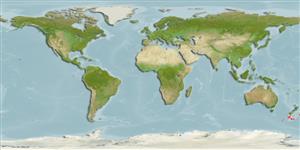Klassifizierung / Names
Namen | Synonyme | Catalog of Fishes(Gattung, Arten) | ITIS | CoL | WoRMS | Cloffa
>
Perciformes/Cottoidei (Sculpins) >
Psychrolutidae (Fatheads)
Etymology: Ambophthalmos: The name is derived from the Greek adjective 'ambon' (m.) meaning ridge and noun 'ophthalmos' (m.) meaning eye; describing the protruding orbital ridges characteristic of its species.
Environment: milieu / climate zone / depth range / distribution range
Ökologie
seewasser demersal. Deep-water
Southwest Pacific: NE coast of Macquarie Island (54°S, 159°E); more northerly populations may exist (Ref. 76761)..
Size / Gewicht / Alter
Maturity: Lm ? range ? - ? cm
Max length : 25.0 cm SL Männchen/unbestimmt; (Ref. 38032)
Life cycle and mating behavior
Geschlechtsreife | Fortpflanzung | Ablaichen | Eier | Fecundity | Larven
Jackson, K.L. and J.S. Nelson, 1999. Ambophthalmos eurystigmatephoros: a new species of fathead sculpin (Scorpaeniformes: Psychrolutidae) from New Zealand. Copeia 1999(2):428-433. (Ref. 38032)
IUCN Rote Liste Status (Ref. 130435: Version 2024-1)
Bedrohung für Menschen
Harmless
Nutzung durch Menschen
Tools
Zusatzinformationen
Download XML
Internet Quellen
Estimates based on models
Preferred temperature (Ref.
123201): 3.5 - 4, mean 3.7 °C (based on 2 cells).
Phylogenetic diversity index (Ref.
82804): PD
50 = 0.6250 [Uniqueness, from 0.5 = low to 2.0 = high].
Bayesian length-weight: a=0.01000 (0.00244 - 0.04107), b=3.04 (2.81 - 3.27), in cm total length, based on all LWR estimates for this body shape (Ref.
93245).
Trophic level (Ref.
69278): 3.5 ±0.3 se; based on size and trophs of closest relatives
Fishing Vulnerability (Ref.
59153): Low vulnerability (21 of 100).
